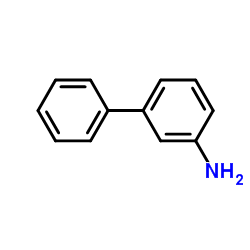3-Biphenylamine

3-Biphenylamine structure
|
Common Name | 3-Biphenylamine | ||
|---|---|---|---|---|
| CAS Number | 2243-47-2 | Molecular Weight | 169.222 | |
| Density | 1.1±0.1 g/cm3 | Boiling Point | 341.7±21.0 °C at 760 mmHg | |
| Molecular Formula | C12H11N | Melting Point | 28-33ºC | |
| MSDS | Chinese USA | Flash Point | 177.0±17.4 °C | |
| Symbol |

GHS07 |
Signal Word | Warning | |
|
Hemoglobin adducts of aromatic amines: associations with smoking status and type of tobacco.
Proc. Natl. Acad. Sci. U. S. A. 85(24) , 9788-91, (1988) Hemoglobin adducts of 15 aromatic amines were determined in nonsmokers and smokers of blond- or black-tobacco cigarettes living in Turin, Italy. The subjects were all males age 55 or less and were representative of the population previously examined in a case... |
|
|
Haemoglobin adducts of aromatic amines in people exposed to cigarette smoke.
IARC Sci. Publ. (89) , 133-6, (1988) In a population-based study in Turin, Italy, smokers of blond tobacco showed 4-aminobiphenyl (4-ABP) adduct levels some three times higher than nonsmoking subjects, and smokers of black tobacco showed levels about five times greater than nonsmokers. A dose-re... |
|
|
Elevated blood levels of carcinogens in passive smokers.
Am. J. Public Health 79(10) , 1381-4, (1989) The hypothesis that involuntary exposure to tobacco smoke--passive smoking--results in greater risk of cancer was assessed by measuring the levels of two known carcinogens in the blood of 57 nonsmokers with varying degrees of involuntary exposure, including s... |
|
|
Nonsmoking-related arylamine exposure and bladder cancer risk.
Cancer Epidemiol. Biomarkers Prev. 12(6) , 503-7, (2003) Roughly one-half of bladder cancer incidence in the United States can be attributed to known causes, mainly cigarette smoking, and it has been hypothesized that the aromatic amines in tobacco smoke are important etiological agents. Nonsmokers are also exposed... |
|
|
Haemoglobin adducts formed by aromatic amines in smokers: sources of inter-individual variability.
Br. J. Cancer 61(4) , 534-7, (1990) In a previous study we found that aromatic amines, particularly 4-aminobiphenyl, formed haemoglobin adducts at higher concentrations in the blood of smokers compared to non-smokers. We re-analyse here data on haemoglobin adducts of 14 aromatic amines in order... |
|
|
Carotenoids/vitamin C and smoking-related bladder cancer.
Int. J. Cancer 110(3) , 417-23, (2004) Previous epidemiological studies of fruit and vegetable intake and bladder cancer risk have yielded inconsistent results, especially with respect to the role of cigarette smoking as a possible modifier of the diet-bladder cancer association. A population-base... |
|
|
CYP1A2 and NAT2 phenotyping and 3-aminobiphenyl and 4-aminobiphenyl hemoglobin adduct levels in smokers and non-smokers.
Toxicol. Appl. Pharmacol. 213(3) , 198-206, (2006) Some aromatic amines are considered to be putative bladder carcinogens. Hemoglobin (Hb) adducts of 3-aminobiphenyl (3-ABP) and 4-aminobiphenyl (4-ABP) have been used as biomarkers of exposure to aromatic amines from cigarette smoke. One of the goals of this s... |
|
|
Metabolism of [14C]2-aminobiphenyl in vivo by different species.
Eur. J. Drug Metab. Pharmacokinet. 12(4) , 285-90, (1987) [14C] 2-Aminobiphenyl is predominantly metabolised in vivo to 3- and 5-hydroxy conjugated derivatives in all species. In some species, 2-aminobiphenyl is also excreted to a small extent as N-conjugated derivatives. Renal excretion accounts for about 30-40% of... |
|
|
The metabolism of 3-aminobiphenyl and 3-acetamidobiphenyl in vitro.
Anticancer Res. 6(4) , 729-31, (1986) The metabolism of 3-aminobiphenyl (3-ABP) and 3-acetamidobiphenyl (3-AABP) has been studied using fortified rat liver microsomal preparations. Metabolites in concentrates of ether extracts from hepatic microsomal preparations were analysed by TLC and GLC. The... |